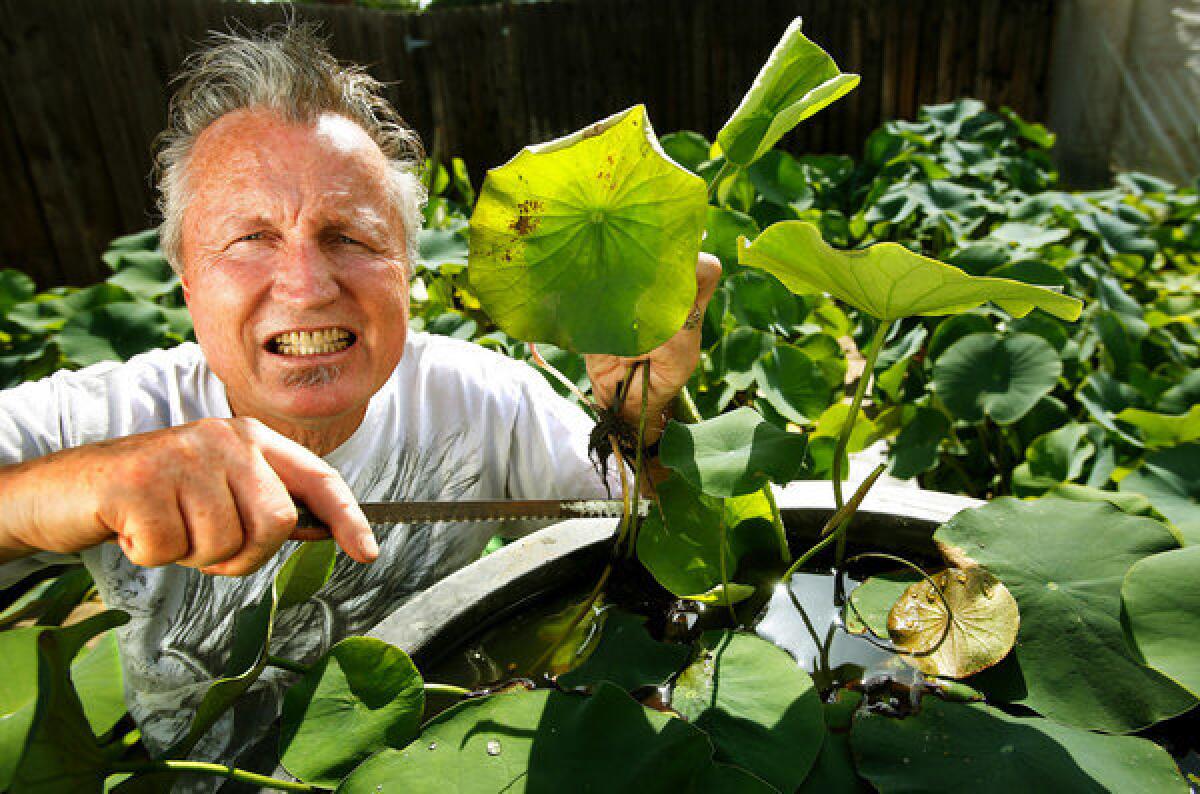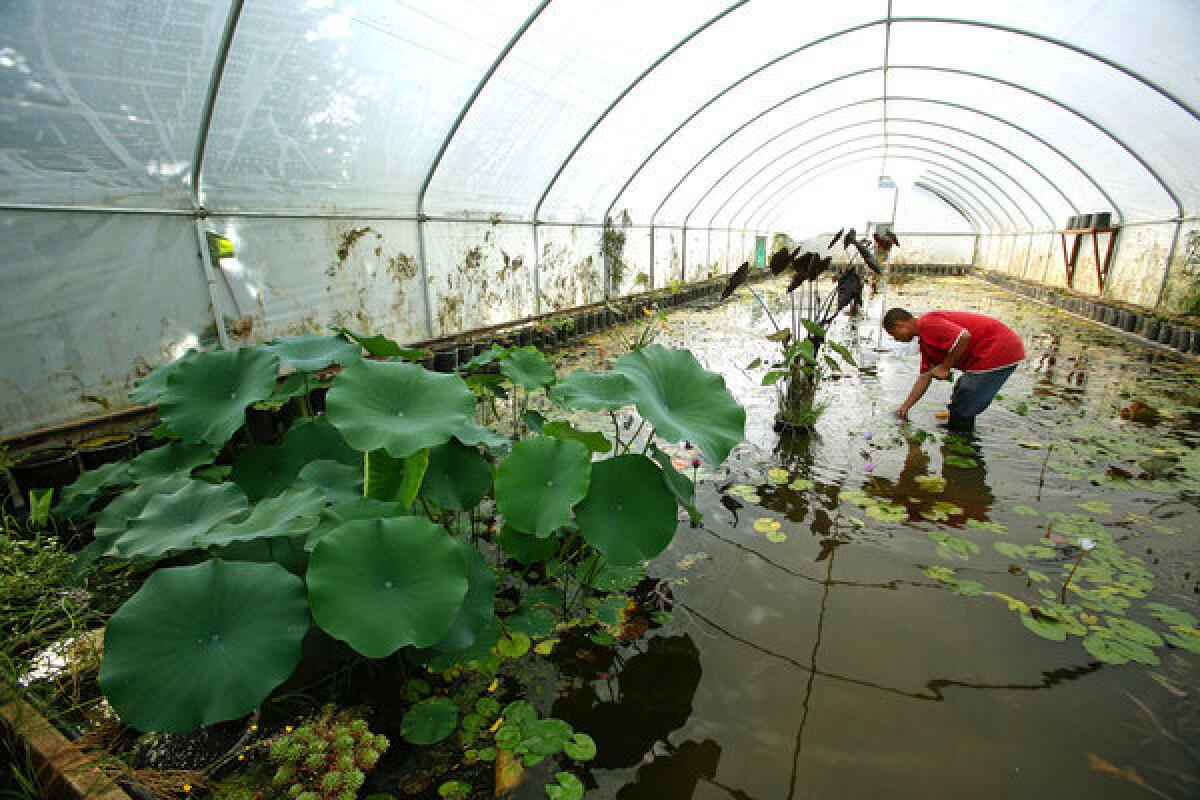The salvation of Echo Park’s lotus bed is rooted in a bit of thievery
Years ago, an impetuous, and illegal, act by a Reseda horticulturist preserved the lotus species that would later die out in Echo Park Lake.
- Share via

Randy McDonald darted his eyes between the lotus bed and a pack of police officers, wondering if he could get away with it.
He figured it was worth a try and walked from Echo Park Lake back to his car. After opening the glove compartment, he pulled out a hacksaw blade and stuck it into his back pocket. He tugged his T-shirt to cover it and returned to the lake.
He worked his way through the thick crowd of revelers gathered for the 28th annual Lotus Festival and then crouched down at the water's edge. Five quick cuts freed a single strand of tiny tubers from the tangle. He shoved it in a plastic trash bag and walked away. He smiled. No one had noticed.
"There was like megatron security," he says, recalling that sunny summer weekend eight years ago when he made off with the clipping.
He took the foot-long illicit strand back to his nursery in Reseda and started growing runners — offering them for sale.
Back then, he had no idea that this stealth act of disobedience — the city's municipal code prohibits cutting or removing plants from parks — would end up saving Echo Park's revered symbol from extinction.

Echo Park Lake began as a man-made reservoir, and city fathers added the park more than a century ago, creating a green haven at what was then the city's edge. The lotuses showed up in the 1920s — history's fuzzy on where they came from and who put them in the lake. Before long, the blush-and cream-colored flowers and bright green, coffee filter-shaped leaves blanketed the lake's northern tip.

Frank Zepeda tends to lotuses in McDonald's Reseda greenhouse. More photos
As the hearty flowers spread, so did the city's desire to protect and honor them.
In the spring of 1929, the parks department banned "all the ducks and two swans on the lake at Echo Park," according to a story in The Times. The birds' indiscretion? "Dining on lotus shoots with such avidity that the plants do not have any chance to develop."
By the 1970s, the flowers were celebrated in an annual festival. The neighborhood council has since used the lotuses in its logo, and an artist featured them in a good-sized section of the mural that curves around the clinic at Echo Park Avenue and Sunset Boulevard.
"I don't think there is any other symbol that encapsulates the whole community in the same way," said Todd Walker of the Greater Echo Park Elysian Neighborhood Council.
About seven years ago, the flowers started to shrivel and the leaves began to brown. By 2008, they had disappeared. Some people blamed the lake's dirty water, others accused natural predators — fish, turtles and crawfish. A crew of biologists did a study, but they never pinpointed a cause.
People still showed up for the now-lotusless Lotus Festival. To cope with the loss, one resident set up a memorial. He glued pictures of lotuses to sticks and planted them along the bank near where they once thrived.
In 2007, the Los Angeles City Council approved the money needed to drain and restore the lake. Sketches hinted that the lotus beds would return.
My specialty is reproduction ... If you ever read the Bible, the fish and the bread growing like crazy, I'm that kind of guy when it comes to plants."— Randy McDonald
The question was how.
The city wouldn't find out for a while, but their answer — the native nelumbo nucifera — was growing in a hothouse half an hour away. Under the trained eye of a sneaky horticulturist.

When McDonald, 66, reflects on his serendipitous snipping, he credits his prescience. It's like the hunch he got before guessing a girl's favorite song on a first date. Or the time he picked out on the first try the perfect bowling ball for a stranger.
"I'm like a soothsayer," he says.
Taking the stalk was lucky, he admits, but propagating it took skill. A lotus plant has to be pruned, and if done incorrectly he says, water siphons into its hollow stems and it drowns.
On a recent afternoon, he walks to a bucket of lilies and dips his fingers into the water, checking its temperature. Then he brushes his right hand — the fingernails packed with soil — through a pot thick with hair grass and smiles, pleased with its growth.
"My specialty is reproduction," he says. "If you ever read the Bible, the fish and the bread growing like crazy, I'm that kind of guy when it comes to plants."
When it comes to gardening, he says, details are gospel. He spends hours sorting through thousands of seedlings searching for one that looks a tiny bit different — an outlier that he can use to grow a hybrid. Even his descriptions of plant colors are particular. Things aren't red or pink. They're Russian red and pinky salmon. Alfalfa green and mustard yellow.

A worker walks along Echo Park Lake during its renovation. (Mel Melcon / Los Angeles Times) More photos
Of the thousands of colorful plants that sprawl over the acre-and-half nursery behind McDonald's home, the lotuses afloat in a pool stand out. Each time he inspects the flowers, he is reminded of the first glimpse he got eight years ago. McDonald hadn't planned to swipe a snipping, but when he showed up at the Lotus Festival with his fiancé that year, the beauty of the plants overwhelmed him.
Over the years, he told just a few people of his lotus heist. Customers who bought the flowers had no idea of their origin.
As the lake restoration got underway, McDonald received calls asking: Were the rumors true? Did he have an offshoot of the lake's lotuses?
Landscape architect Josh Segal tracked him down after hearing from a plant expert in Santa Barbara that McDonald might have a clipping.
When he broached the topic of how McDonald had the plants, the gardener told the truth, said Segal, who works for the firm that designed the lake's $45-million makeover.
Finding McDonald gave the restoration "a special story that involves theft," Segal said, breaking into a laugh. "It's L.A."
Once McDonald sensed an interest in the original lotus plants, he began bartering. He jokingly says he held the lotuses hostage as he persuaded the city to let him provide all the plants for the lake's wetlands.
Getting the lotus contract wasn't a sure thing. There was talk of asking countries to donate different varieties of the plant. McDonald chimed in.
"The only thing people really want is their lotus back," he said. "I've got it. Let's stop bickering around. Buy it from me."
He laughs a bit, slapping his knee as he recalls his brazen pitch — and its result.

Echo Park Lake's famous lotus plants have been restored and protected by plastic netting. During the cleanup, said L.A.'s city engineer, workers found two guns, one toilet, 20 Frisbees and a pay telephone. (Mark Boster / Los Angeles Times) More photos
After a little more than a year, he sold the city 376 lotus plants — offshoots of the strand he took in 2005. The price? $30,000.
"We were happy to bring the same plant back," said Alvaro Prada, who works in the city's Bureau of Engineering and helped with the project.
Last month, Prada and other city officials toured the restored lake. They followed the shoreline to a vigorous patch of green. Then they stopped.
The sprawl of the new lotuses wears a veil of protective black mesh. "We're erring on the side of lotus safety," City Engineer Gary Moore said.
Unlike before, the plants don't jut against the shore. Confined by the net — which will stay on for a year — the lotuses stop several feet away, well out of reach.
Nearby, a plaque set into the walkway warns:
"Do not disturb habitat."
Follow Marisa Gerber (@marisagerber) on Twitter
More great reads
Sign up for Essential California
The most important California stories and recommendations in your inbox every morning.
You may occasionally receive promotional content from the Los Angeles Times.











